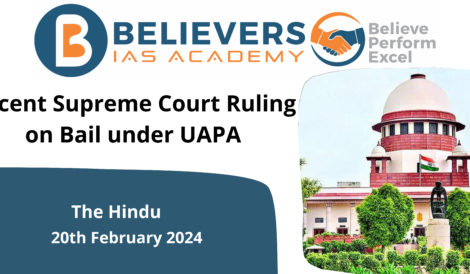Disaster Response Fund
Context:
The recent disagreement between the Central and Tamil Nadu governments regarding flood relief brings attention to the crucial need for well-defined criteria in allocating disaster assistance.
Relevance:
GS03 (Disaster Management)
Mains Question:
Evaluate the disagreements between the Centre and State governments regarding flood relief and propose measures to enhance the efficiency and transparency of disaster management frameworks in India, with a focus on inclusive relief policies. (250 words)
Dimensions of the Article:
- State Disaster Response Fund (SDRF)
- Contribution Mechanism
- Covered Disasters under SDRF
- Flood Relief Funds in India
State Disaster Response Fund (SDRF)
- Established under Section 48 (1) (a) of the Disaster Management Act, 2005, the State Disaster Response Fund (SDRF) serves as a crucial financial resource for State governments in responding to officially declared disasters.
- Its formation stems from the recommendations of the 13th Finance Commission, and the fund undergoes annual audits by the Comptroller and Auditor General of India (CAG).
- In addition to responding to officially notified disasters, State Governments have the flexibility to allocate up to 10% of SDRF funds for providing immediate relief in response to locally perceived disasters.
- These local events, deemed ‘disasters’ within the state context, are not explicitly listed in the Ministry of Home Affairs’ notified disasters. This provision allows for a tailored and flexible response to emerging challenges at the local level.
Contribution Mechanism
- The SDRF receives contributions from the Central government, with different allocation percentages for general and special category States and Union Territories.
- General category entities receive 75% of their SDRF allocation, while special category regions (including northeastern States, Sikkim, Uttarakhand, Himachal Pradesh, Jammu and Kashmir) receive 90%.
- The Central contribution is released biannually in two equal installments, aligning with the recommendations of the Finance Commission.
Disasters covered under SDRF
- The SDRF is designed to address a spectrum of disasters, encompassing both natural and climatic events.
- These include cyclones, droughts, earthquakes, fires, floods, tsunamis, hailstorms, landslides, avalanches, cloudbursts, pest attacks, frost, and cold waves.
Flood Relief Funds in India
- PM CARES Fund: Established by the Indian government as a public charitable trust. Aims to provide relief to citizens during emergency situations.
- State Disaster Response Fund (SDRF): Constituted to offer immediate relief for officially notified disasters within a state. Central government contributes 75% for general category states and UTs, and 90% for special category states and UTs.
- National Disaster Response Fund (NDRF): Managed by the central government to address expenses related to emergency response, relief, and rehabilitation. Utilized for various natural calamities, including earthquakes, cyclones, drought, fire, tsunami, floods, landslide, hailstorm, avalanche, pest attack, and cloud burst.
Way Forward:
- The recent episode emphasizes the urgency of establishing transparent, well-defined criteria for disaster relief allocation. Streamlining the process, expanding the scope of relief measures, and considering the unique challenges faced by sectors like MSMEs are important.
- Collaborative efforts between the Centre and states, especially those vulnerable to cyclones, can pave the way for a more effective and non-controversial disaster management framework.



